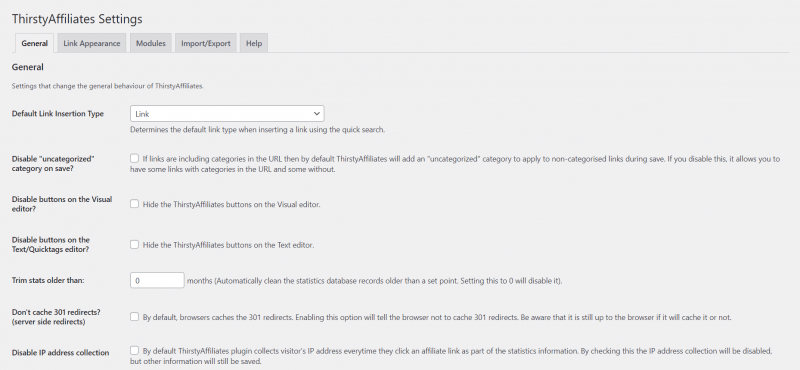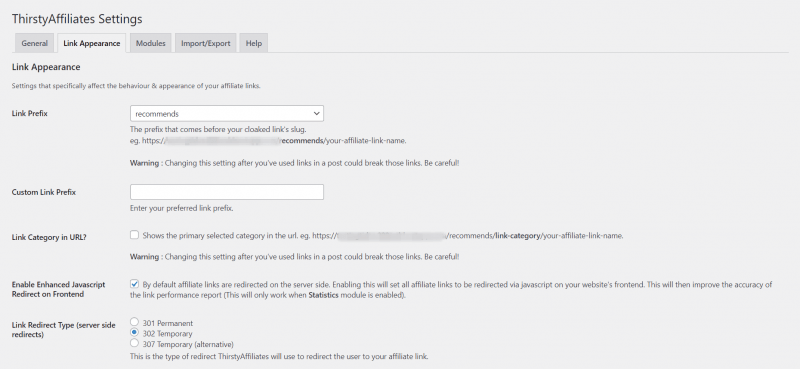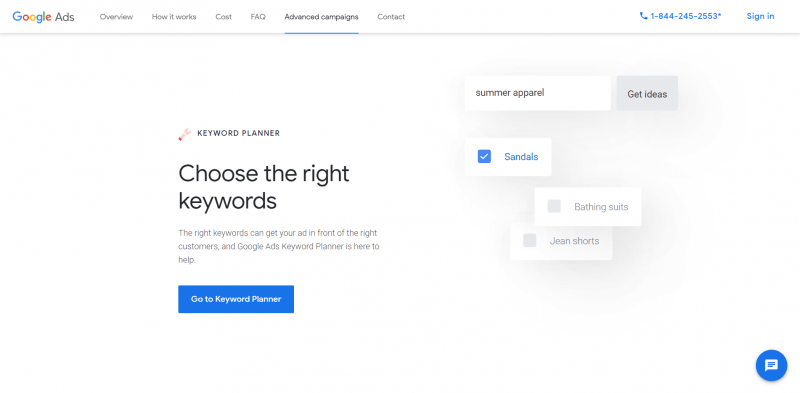Contenido

Los enlaces son la principal herramienta utilizada por los vendedores afiliados para impulsar las conversiones. Sin embargo, las URL proporcionadas por los afiliados pueden ser complicadas y desordenadas. Esto no solo puede confundir a tus visitantes, sino que también puede ser una oportunidad perdida para mejorar tu posicionamiento en buscadores (SEO).
Afortunadamente, las babosas de URL son una herramienta eficaz para hacer frente a estos desafíos. Mediante el uso de un plugin de encubrimiento de enlaces como ThirstyAffiliates y tomando decisiones deliberadas con su redacción, puede crear URL personalizadas para comunicarse mejor con sus visitantes y aumentar la visibilidad general.
En este artículo, le daremos una visión general de lo que es un slug de URL y cómo puede desempeñar un papel en el éxito de su sitio. A continuación, le daremos tres sencillos consejos que le ayudarán a maximizar el potencial de un slug. Empecemos.
Introducción a la URL Slug
Un slug es la parte de una URL que indica el contenido de una página determinada. Puedes utilizarlo para informar a los visitantes sobre entradas específicas, páginas de destino o enlaces de afiliación ocultos.
Por ejemplo, veamos uno de los artículos recientes de nuestro blog, titulado Cómo definir su público objetivo (3 consejos clave). La dirección en su barra de búsqueda será https://thirstyaffiliates.com/blog/define-your-target-audience. Esta parte es la babosa: "defina-su-público-objetivo“.
Un slug de URL preciso tiene el potencial de impulsar su SEO. Las palabras clave relevantes desempeñan un papel importante en la clasificación, por lo que añadirlas a las URL es una forma sencilla de aumentar el tráfico de forma orgánica. Los slugs también pueden crear enlaces más memorables y fáciles de usar para su audiencia.
Las URL eficaces son una parte sencilla pero importante de su estrategia de marketing. campaña de marketing de afiliación. Afortunadamente, son bastante fáciles de crear. Con un poco de planificación, podrás sacar el máximo partido a tus babosas.
Cómo optimizar una URL Slug (3 consejos)
Si desea crear un slug de URL con el máximo impacto, aquí tiene algunas estrategias a tener en cuenta.
1. Camufle sus enlaces con ThirstyAffiliates
Como afiliado, es probable que tengas que hacer malabarismos con muchos enlaces con URL largas y complejas. Enmascaramiento de enlaces es una estrategia inteligente que le ayudará a crear slugs sencillos y personalizados para su sitio. Si esto le parece útil, debería considerar probar nuestro ThirstyAffiliates plugin:

Enmascarar URLs con ThirstyAffiliates también ofrece otras ventajas. Por ejemplo, si desea realizar un seguimiento del éxito de sus enlaces, puede utilizar los informes detallados del software. También puede interesarle utilizar los enlaces de geolocalización proporcionados para enfocar con mayor precisión sus contenidos.
Una vez que hayas descargado ThirstyAffiliates, crear una URL slug para tus enlaces de afiliado camuflados es muy sencillo. En primer lugar, vaya a ThirstyAffiliates > Ajustes. Eso debería llevarte a la General página:

Desde ahí, puedes pasar a la siguiente pestaña, Enlace Apariencia. Esa sección debería tener este aspecto:

Consulte la primera opción de la página Prefijo del enlace. Esto decidirá qué texto precede al slug elegido. Puede elegir entre una amplia lista de prefijos o crear el suyo propio.
Por último, te recomendamos que elijas con cuidado y evites cambiar este prefijo. Dado que el prefijo irá antes del slug en todos tus enlaces de afiliado, mantenerlo consistente puede evitar URLs rotas y visitantes confusos.
2. Mantenga sus babosas concisas
Un slug puede ser una herramienta poderosa para hacer que las URL densas sean más accesibles. Puede duplicar este beneficio creando el slug más corto posible que refleje claramente el contenido al que conduce. Este enfoque también ayudará a que su sitio sea más fácil de navegar.
Del mismo modo, cada URL slug es única y sólo puede utilizarse una vez. Por lo tanto, debería centrarse en frases únicas y específicas. Esto le ayudará a definir sus enlaces a la vez que los mantiene breves.
Por ejemplo, supongamos que tiene un blog de cocina con enlaces afiliados a productos de cocina. Si quiere publicar una receta de tortilla de patatas, probablemente tenga sentido explicárselo claramente a sus visitantes. Una babosa, como "huevos", puede ser corta, pero también vaga.
Utilizar una palabra más precisa como "tortilla" puede ser una mejor opción. Si se especifica más con un término como "classic-french-omelet", su contenido será especialmente claro. Es más probable que un usuario que busque una receta de tortilla francesa clásica visite su página, ya que tiene una URL precisa y fácil de usar.
Por último, es posible que desee mantener todas esas palabras útiles en minúsculas. De este modo evitará errores ocasionales del servidor web, en los que palabras idénticas con distintas mayúsculas se consideran URL totalmente diferentes. También hace que la URL sea más fácil de recordar y de escribir correctamente.
3. Incorpore palabras clave relevantes
Terminemos hablando de la elección de palabras. Si desea mejorar su posicionamiento orgánico en los motores de búsqueda, puede considerar la posibilidad de utilizar las palabras clave de forma estratégica. Incorporar palabras relevantes en tus slugs es una parte importante para hacer tu sitio más visible.
Si desea orientación para elegir las palabras clave más eficaces, le recomendamos que utilice Planificador de palabras clave de Google:

Este sitio polivalente puede ayudarle a generar ideas para nuevas palabras clave, calcular las estadísticas de competencia de determinadas palabras de su slug y proporcionarle una cifra aproximada de cuántas personas buscan temas relacionados. Puedes utilizar tantas herramientas como necesites.
Una vez que haya encontrado las palabras clave perfectas para sus enlaces, puede escribir un slug eficaz. Como consejo final, le recomendamos que evite utilizar palabras reservadas siempre que sea posible. Palabras como "a", "con" y "a" ocupan espacio sin ayudar a su SEO.
Esta estrategia requiere un poco de planificación previa. Sin embargo, todas las técnicas anteriores pueden ayudarle a impulsar su SEO y dirigir más tráfico a sus enlaces de afiliado.
Conclusión
Los enlaces son una parte esencial de generar más tráfico para su sitio web de marketing de afiliación. Afortunadamente, los slugs de URL suponen una mejora práctica con respecto a los enlaces predeterminados. Mediante el uso estratégico de palabras clave, puede mejorar simultáneamente su sitio para los visitantes y las clasificaciones SEO por igual.
En este artículo, cubrimos tres pasos para ayudarle a optimizar un slug de URL:
- Utilice un camuflador de enlaces como ThirstyAffiliates.
- Opte por babosas más cortas y descriptivas.
- Asegúrese de utilizar las palabras clave más relevantes para su contenido.
¿Tiene alguna pregunta sobre las babosas URL?? Háganoslo saber en la sección de comentarios.
Si te ha gustado este post, no dejes de seguirnos en Twitter, Instagram, Facebooky LinkedIn¡! Y no olvides suscribirte en el caja abajo.



Incluya las palabras clave por las que desea posicionarse.
Considere la posibilidad de eliminar las palabras clave de parada.
Utilice guiones para separar palabras en una babosa.
Que sea breve.
Utilice sólo minúsculas.
bonito
Gracias por el artículo, pongo mi palabra clave principal en el slug y puede ayudar en SEO.
Esto siempre me confunde. En toda la formación que usted dice que usted tiene que establecer un prefijo de enlace, por ejemplo, mysite.com/recomienda / enlace afiliado, pero todos sus usuarios que he visto simplemente tienen mysite.com / enlace afiliado como la url del enlace (sin ningún prefijo subdirectorio). ¿Cómo es posible?
Gracias por el blog, como una persona SEO he utilizado palabras clave específicas en babosa que me ayuda a optimizar las palabras clave.
Gracias chicos. Esto es muy útil. En realidad hasta leer esto me había olvidado por completo de la URL.
Muchas gracias.